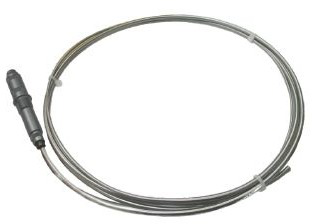Self-Powered Neutron Detectors has been used effectively as in-core flux monitors in nuclear power reactors world-wide. The basic properties of these radiation sensors include nuclear, electrical and mechanical characteristics. The proper choice of the self-powered detector emitter to provide the proper response time and radiation sensitivity desired for use in an effective in-core radiation monitoring system.
SPND can be of many types. The typical inconel type SPND is a coaxial cable consisting of an inner electrode of inconel (the emitter), surrounded by insulation and an outer electrode of inconel (the collector). Preferably, the lead cable and detector sections are integral, i.e. the signal wire of the lead cable mates directly to the emitter; the insulation of both sections are identical and the collector of the detector section is also the outer sheath of the lead cable section.In Self-Powered Neutron Detectors (SPNDs), the interactions of neutrons and atomic nuclei are used to produce a current which is proportional to the neutron fluence rate (flux).

Application of SPND:
- It is used for core flux measurement in Nuclear
- The design of SPND is rugged, simple, flexible and long
- It is used for high flux-high
- Indication or
- It is used for mapping or permanent
Advantages of SPND:
- SPND doesn’t require power
- SPND structure is simple and
- SPND has small mechanical size which is desired for in-core
- The stability of SPND is good under temperature and pressure
- SPND generates a reproducible linear
Technical Specification of Inconel type SPND:
For Detector:
| Emitter Material | Inconel 600 |
| Emitter Diameter | 1.40 mm |
| Sensitive Length | Can be made upon request |
| Insulator | MgO |
| Collector Material | Inconel 600 |
| Outer Diameter of detector | 3.00 mm |
For Cable:
| Length of Cable | Can Be made on request |
| Insulator | MgO |
| Sheath Material | Inconel 600 |
| Outer Diameter of Cable | 1.60 mm |
Characteristics:
| Measured Quantity | Neutron Flux |
| Insulation resistance
( at room temperature) |
≥ 1 X 1012 Ώ at 250 VDC |
| Insulation Resistance
(at 300°C) |
≥ 5 X 108 Ώ at 250 VDC |










